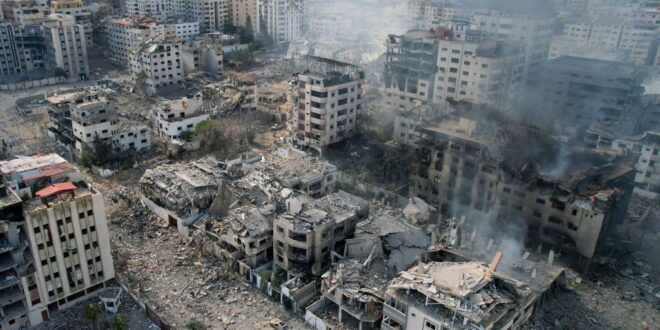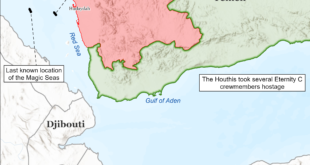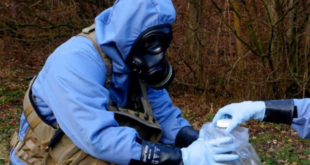When the guns eventually fall silent in Gaza, Israelis and Palestinians will confront a decades-old reality that cannot be overcome by violence and political half-measures. Both Jews and Palestinians will continue to assert privileged ownership of Palestine, citing centuries of history, the merits of which will never be settled conclusively by historians, let alone by the two principals. The question, therefore, is not whether Jews and Palestinians will continue living cheek by jowl, but how. Will they do so amid endless spasms of bloodletting or a coexistence created by a negotiated settlement that reconciles Israel’s need for security with Palestinians’ desire for statehood?
Israeli leaders have long claimed that they cannot negotiate with Hamas, which regards the Jewish state as the culmination of a colonial-settler project produced by Zionism. Yet this insurmountable barrier to a political settlement does not exist in the West Bank — or, more precisely, has not since the Palestinian Liberation Organisation forsook terrorism in 1988, recognised Israel’s right to live in peace, and agreed to negotiate with Israel to create a Palestinian state encompassing the West Bank and Gaza. The PLO’s historic decision paved the way for its leadership’s return, first to Gaza and later to the West Bank, the formation of a governing body, the Palestinian Authority (PA), and the quest for a political settlement that would yield a Palestinian state.
Negotiations that started in 1991 led to two agreements, Oslo I (1993) and Oslo II (1995), with the United States acting as a mediator. The latter accord provided for a tripartite division of the West Bank that gave the PA (qualified) governing rights in Areas A and B and Israel exclusive control over Area C, which made up 61% of the territory. Even now, the PA exercises unshared civil and military authority solely in Area A (18 % of the West Bank). Plus, in both of its zones, the PA’s rights are defined narrowly: Israel controls the West Bank’s airspace, border crossings, telecommunications, water resources and other natural resources.
Moreover, in Areas A and B, the Palestinian population is scattered across “165 disconnected islands”, in contrast to Area C, a sprawling continuous expanse that contains all the Jewish settlements, as well as 200,000 or more Palestinians. Hagai El-Ad, an Israeli and former executive director of the human rights organisation B’Tselem, aptly likens the West Bank’s political geography to Swiss cheese. Israel has never been willing to make the hard choices required to change this patchwork into a territorially continuous sovereign Palestinian state — not even in 2000 at Camp David, despite the mythology that Prime Minister Ehud Barak offered Yasser Arafat, the PA’s leader at the time, a state covering almost all of the West Bank, only to be spurned. In reality, Israel did not present documents or maps, let alone agree to a fully sovereign Palestinian state with a unified territory.
Prime Minister Ehud Olmert’s plan, proposed in September 2008 following a series of meetings with PA president Mahmoud Abbas, went much further; but by then, Olmert was on his last legs politically, and Abbas refused to accept in haste a plan whose future was uncertain. Since then, the two-state concept has withered on the vine, and that has revived the idea of a single state that would provide equal rights to Jews and Palestinians alike.
The resulting frustration revived the idea of a single state that would guarantee equal rights to Jews and Palestinians alike, proposed in Zionism’s early decades by Jewish intellectuals, including Gershom Scholem, Judah Magnes, Martin Buber. Its more recent Israeli proponents have included Meron Benvenisti, Jerusalem’s former deputy mayor, and Oxford historian Avi Shlaim. Among Palestinians, this formula has been advocated by the late Columbia University literary scholar Edward Said, Sari Nusseibeh, a philosophy professor and former president of Al-Quds University (1995-2014) in Jerusalem, and Columbia University historian Rashid Khalidi. Their conceptions of a single and inclusive state’s architecture, while not necessarily identical, rested on the premise that the proliferation of Jewish settlements had made the creation of two separate national states infeasible.
By definition, this solution contradicted the animating principle of the Zionist movement articulated by Theodor Herzl, and later picked up by Ze’ev Jabotinsky and David Ben Gurion: the essentiality of a nation in which Jews have special rights. The vision of one state in which Jews and Palestinians have equal rights appeals, particularly to people on the political Left but is fated to remain on the drawing board. It will never be accepted by the religious parties of the far-Right, represented in the current Israeli coalition government by Itamar Ben Gvir, leader of the Otzma Yehudit party and Minister of National Security since 2022, and Bezalel Smotrich, head of the Religious Zionist Party and Finance Minister, also since 2022; or the secular Right-wing parties, such as Prime Minister Binyamin Netanyahu’s Likud or Avigdor Liberman’s Yisrael Beiteinu.
Nor does the one-state model have much public support. A December 2022 poll conducted by the Palestinian Center for Policy and Survey Research and Tel Aviv University’s International Program for Conflict Resolution and Mediation found that only 20% of the wider Israeli population approved of a single democratic state. It didn’t fare much better among Palestinians: 23% favoured it. The Rightward trajectory of Israel’s politics during the past several years and the deep mistrust produced by Hamas’s October 7 attacks will, if anything, reduce its appeal in both communities.
If the one-state solution stands no chance, might it be possible to resuscitate the two-state version? No — and for several reasons.
Most obviously, there’s the formidable task of transforming the West Bank’s current geographical and political configuration into a Palestinian state worth the name. The territory is speckled with 146 settlements containing 700,000 people (229,000 of whom live in East Jerusalem) as well as 191 “outposts” populated by another 20,000. Added to this, there is the security barrier built east of the Green Line, the Israelis-only roads, the expanded borders of East Jerusalem, and the IDF’s “firing zones” that encompass more than half of the Jordan Valley and Dead Sea littoral. None of these obstacles will be easily swept away, especially since the far-Right religious parties in Israel’s current ruling coalition have made settlement expansion a priority. So far this year, 5,852 acres in the West Bank, including the Jordan Valley, have been declared state land, far more than in any previous year, making them sites for future settlements and other construction projects. And in 2023 alone, the number of settlers increased by 15% during the last five years and by almost 3% last year alone.
Partly as a result, the already deep distrust between Israelis and Palestinians has become deeper because of both the Gaza war and events in the West Bank: the expulsions, destruction and seizures of homes and farmland, persistent torture of Palestinian prisoners (many held without being charged or tried) and, as the Army looks on, attacks by armed settlers against Palestinians. During the past decade, the U.N. recorded 3,372 acts of violence by West Bank settlers; and frequency has increased: between October 7 and early May there were nearly 800 incidents.
A recent example was the rampage by settlers through the town of Huwara to avenge the shooting of two Jewish brothers by a Palestinian. The mob set homes, businesses and vehicles alight, leaving one person dead and hundreds more injured. Israeli security forces accompanied the attackers but did nothing to stop the violence, which Maj. Gen. Yehuda Fox, head of the IDF’s Central Command (which covers the West Bank), condemned as a “pogrom” that desecrated Judaism’s values. By contrast, Finance Minister Smotrich called for Huwara to be “wiped out.” But this lawlessness cannot be blamed solely on individuals such as Ben Gvir; it reflects something deeper — the changing make-up of the Israeli military. According to Yehuda Shaul, who served in the IDF and co-founded the research organization Ofek (The Israel Center for Public Affairs) as well as Breaking the Silence, an association of IDF veterans that exposes the mistreatment of Palestinians, settler violence has increased in recent years because the proportion of nationalist-religious individuals in the infantry’s “cadet officer corps” tied to the settlements jumped from less than 3% in 1995 to 40% by 2015 — a far greater than their share of Israel’s total population.
An optimist might retort that the two-state solution can nevertheless be salvaged and buttress the claim with an array of facts. The largest settlements, such as Ariel, Ma’ale Adumim, Modi’in Illit and Beitar Illit are near the Green Line and could be folded into pre-1967 Israel, with the Palestinian state compensated with land swaps involving Israeli territory. An optimist could also add that Prime Minister Ariel Sharon dismantled the settlements in Gaza in 2005, so a future Israeli leader could do the same, even in the West Bank’s interior and far reaches.
But the fact remains that the settlement enterprise has continued since 1967 regardless of the political bent of Israeli governments and the settler population nearly doubled even between 1994 and 2000, the hope-laden years of the peace process. Plus, the current Right-wing government is determined to expand construction and settlements on the West Bank, which, as Smotrich has stated openly, it sees as essential to block a Palestinian state, the very idea of which was rejected in a declaration adopted by the Knesset in July. Unless Israel’s politics undergo a dramatic transformation, what Sharon did in Gaza in 2005 cannot be replicated in the West Bank. Especially since, compared to the settlements in Gaza, those in the West Bank are not only far more numerous and populous — they have infinitely more historical and religious significance. What is Gaza’s equivalent of the Tomb of the Patriarchs or Rachel’s Tomb?
Israel cannot of course accept Hamas’s objective in Palestine: that would amount to self-liquidation. But by failing to do what’s needed for a meaningful two-state solution, it has made the PA appear feckless in the eyes of Palestinians. Hamas’s electoral victory in the 2006 legislative elections in the West Bank and Gaza owed in no small measure to the fact that the Palestinian Liberation Organization, having rejected terrorism in 1988 and committed itself to negotiations with Israel, failed to deliver. In short, Israel’s policy of “mowing the lawn” — a euphemism for the intermittent quelling of Palestinian revolts — has helped Hamas.
Today, most Palestinians see the PA as a corrupt entity and the local gendarme Israel needs to perpetuate the occupation. The PA hasn’t held an election since 2006 and would be roundly rejected if it did. In a poll conducted soon after the Gaza War began, 90% of West Bank Palestinians said that PA president Mahmoud Abbas should resign. Conversely, a US intelligence assessment concluded that the war had substantially increased the popularity of Hamas and Islamic Jihad in the West Bank. Palestinian politics, in other words, are not moving in a direction conducive to a two-state solution.
“Most Palestinians see the PA as a corrupt entity and the local gendarme Israel needs to perpetuate the occupation.”
On the other side of the ledger, the occupation has led to Israel’s increasing global isolation. The most recent example is the International Court of Justice’s July ruling that the occupation violates international law, including parts of the Fourth Geneva Convention and the Hague Regulations. Elsewhere, a May General Assembly resolution on admitting Palestine as a full member of the UN was approved by 143 countries, with 25 abstaining, and nine opposing the resolution. To attain that status, Palestine needs the Security Council’s approval, with a minimum of nine positive votes and no vetoes by permanent members. Still, it’s notable that an April Security Council resolution proposing full membership for Palestine received 12 positive votes; two countries (the UK and Switzerland) abstained and the US cast its veto.
Since then, Israel has seemed determined to turn itself into an international pariah. It has continued to expand its settlements; there are reports of the torture and sexual humiliation of Palestinian prisoners; its bombing campaign in Gaza, enabled by American backing, continues to claim the lives of children and civilians.
Sadly, absent a fundamental change in Israeli politics and an end to unqualified US support, political and material, what lies ahead is the continuation of the deadly and dead-end “mowing the lawn” reflex. The consequences, the past tells us, are all too predictable. To invert the quip of the muckraking American journalist Lincoln Steffens on a trip to the Soviet Union, we have seen the future, and it does not work — for the Palestinians and Israelis alike.
 Eurasia Press & News
Eurasia Press & News


